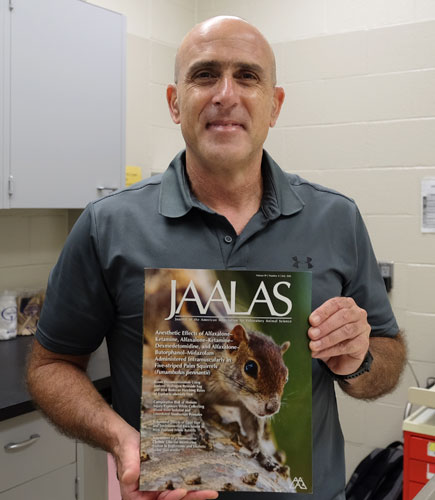August 13, 2020
Historical research collaboration puts cute squirrel on journal cover

While it looks relatively harmless — and cute — international trade involving the five-striped palm squirrel has led to some very undesirable problems. New research in the Kansas State University College of Veterinary Medicine is helping to put this species of squirrel on the map, so to speak, and on the cover of the latest issue of the Journal of the American Association for Laboratory Animal Science.
David Eshar, associate professor in companion exotic pets, wildlife and zoo animal medicine, spent the last two years collaborating with the Tisch Family Zoological Gardens in Jerusalem, Israel, examining the northern palm squirrel. The five-striped palm squirrel is native to India, Pakistan, Nepal, Bangladesh and Iran, but can become a feral invasive species through illegal pet trade.
"This squirrel species is a huge problem in Australia," Eshar said. "For me as a zoo medicine specialist, this has been a great opportunity to perform research and generate novel clinical knowledge in an uncommon species. This is part of the historical collaboration I have with the Jerusalem zoo. This is a great opportunity for Israeli zoo vets and students to take part in zoo-related research."
In his research article on these squirrels, Eshar explored three different injectable anesthesia protocols thanks to support from a Department of Clinical Sciences research grant. The research title is "Anesthetic Effects of Alfaxalone–Ketamine, Alfaxalone–Ketamine–Dexmedetomidine, and Alfaxalone–Butorphanol–Midazolam Administered Intramuscularly in Five‑striped Palm Squirrels (Funambulus pennantii)."
This publication is added to another recent and major publication from this project by Eshar and his collaborator, Hugues Beaufrère, a faculty member at the Ontario Veterinary College at the University of Guelph. That article, "Anesthetic effects of dexmedetomidine-ketamine-midazolam administered intramuscularly in five-striped palm squirrels (Funambulus pennantii)," and was published in the American Journal of Veterinary Research in 2019.
"A systematic review of the literature showed that no similar anesthesia regimens had been used previously in palm squirrels," Eshar said. "The combination of agents we tested was designed to provide balanced and — depending on the protocol — partially reversible anesthesia that enables practical recommendations for treatment of these animals. It was exciting to have this research featured on the cover of JALAAS. This is a nice gesture and an honor for anyone, as JAALAS is the most respected journal in its field."
The Jerusalem zoo is opening an exhibit for this squirrel species to better inform the public about the squirrels. Eshar said this is an invasive species under strict control by the Israeli national wildlife authorities. The research serves a part in allowing zoo officials to educate the public on the dangers of such invasive species.
